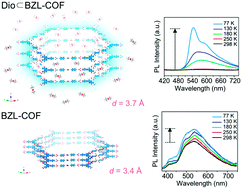Covalent organic frameworks: a platform for the experimental establishment of the influence of intermolecular distance on phosphorescence†
Abstract
We report herein a two-dimensional (2D) COF (BZL-COF) based on an representative crystallization-induced phosphorescence (CIP) organic phosphor, benzil, for phosphorescence study. In BZL-COF, the CIP building blocks are arranged in an eclipsed fashion similar to the face-to-face mode in H-aggregates. The phosphorescence behavior significantly changed from on to off at cryogenic temperature upon altering the interlayer distance from 3.7 Å to 3.4 Å by removing the solvent molecules trapped between the 2D polymeric layers. In comparison, a single crystal of the model compound that adopts an H-type aggregation with an intermolecular distance of 4.1 Å can exhibit strong phosphorescence at room temperature. Our study shows that, in addition to the restriction of intramolecular rotation and H-aggregated packing, suitable intermolecular distance also plays a vital role in enhancing the phosphorescence.



 Please wait while we load your content...
Please wait while we load your content...